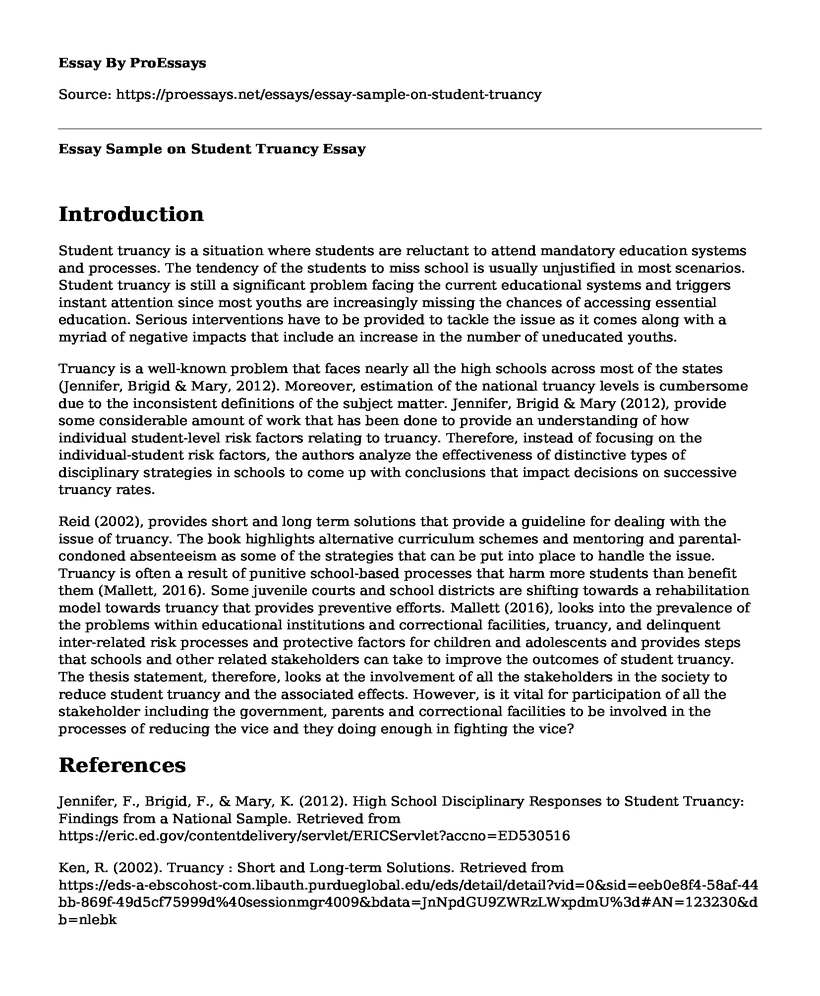Introduction
Student truancy is a situation where students are reluctant to attend mandatory education systems and processes. The tendency of the students to miss school is usually unjustified in most scenarios. Student truancy is still a significant problem facing the current educational systems and triggers instant attention since most youths are increasingly missing the chances of accessing essential education. Serious interventions have to be provided to tackle the issue as it comes along with a myriad of negative impacts that include an increase in the number of uneducated youths.
Truancy is a well-known problem that faces nearly all the high schools across most of the states (Jennifer, Brigid & Mary, 2012). Moreover, estimation of the national truancy levels is cumbersome due to the inconsistent definitions of the subject matter. Jennifer, Brigid & Mary (2012), provide some considerable amount of work that has been done to provide an understanding of how individual student-level risk factors relating to truancy. Therefore, instead of focusing on the individual-student risk factors, the authors analyze the effectiveness of distinctive types of disciplinary strategies in schools to come up with conclusions that impact decisions on successive truancy rates.
Reid (2002), provides short and long term solutions that provide a guideline for dealing with the issue of truancy. The book highlights alternative curriculum schemes and mentoring and parental-condoned absenteeism as some of the strategies that can be put into place to handle the issue. Truancy is often a result of punitive school-based processes that harm more students than benefit them (Mallett, 2016). Some juvenile courts and school districts are shifting towards a rehabilitation model towards truancy that provides preventive efforts. Mallett (2016), looks into the prevalence of the problems within educational institutions and correctional facilities, truancy, and delinquent inter-related risk processes and protective factors for children and adolescents and provides steps that schools and other related stakeholders can take to improve the outcomes of student truancy. The thesis statement, therefore, looks at the involvement of all the stakeholders in the society to reduce student truancy and the associated effects. However, is it vital for participation of all the stakeholder including the government, parents and correctional facilities to be involved in the processes of reducing the vice and they doing enough in fighting the vice?
References
Jennifer, F., Brigid, F., & Mary, K. (2012). High School Disciplinary Responses to Student Truancy: Findings from a National Sample. Retrieved from https://eric.ed.gov/contentdelivery/servlet/ERICServlet?accno=ED530516
Ken, R. (2002). Truancy : Short and Long-term Solutions. Retrieved from https://eds-a-ebscohost-com.libauth.purdueglobal.edu/eds/detail/detail?vid=0&sid=eeb0e8f4-58af-44bb-869f-49d5cf75999d%40sessionmgr4009&bdata=JnNpdGU9ZWRzLWxpdmU%3d#AN=123230&db=nlebk
Mallett, C. (2016). Truancy: It's Not About Skipping School. Retrieved from http://dx.doi.org.libauth.purdueglobal.edu/10.1007/s10560-015-0433-1
Cite this page
Essay Sample on Student Truancy. (2022, Jul 29). Retrieved from https://proessays.net/essays/essay-sample-on-student-truancy
If you are the original author of this essay and no longer wish to have it published on the ProEssays website, please click below to request its removal:
- Personal Essay Example - Achieving Goals Through Cooperation
- Essay on Children Fairy Tales
- The Student Experienced Their First Colloquium Paper Example
- A Life-Changing Incident Essay Example
- Gaining Moral Resilience: Defining My Moral Compass - Essay Sample
- Essay Example on Global Business Dynamics: My Experience with Samsung Group
- Free Essay Sample on What College Life Means: Years of Experiences and Ideas







